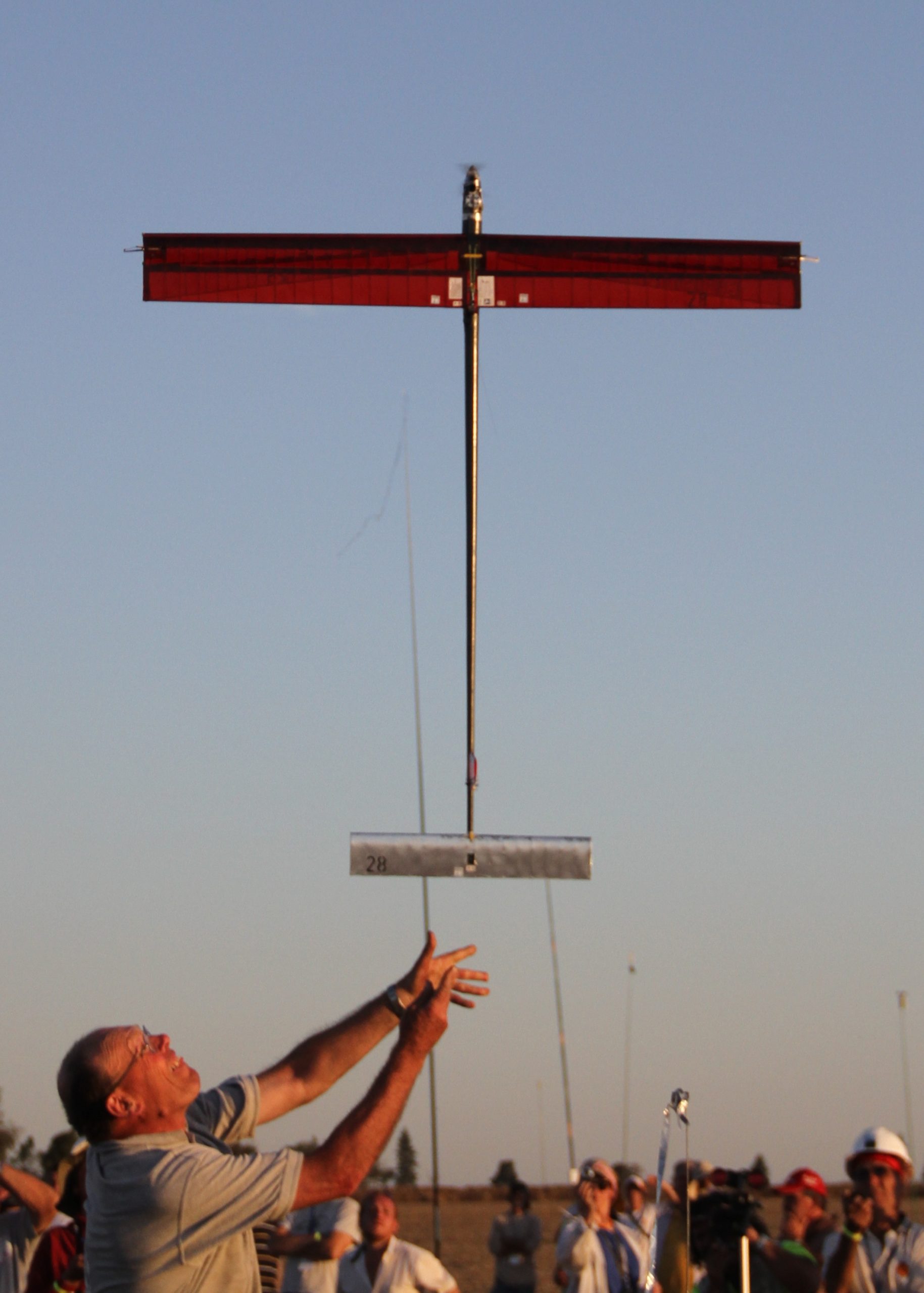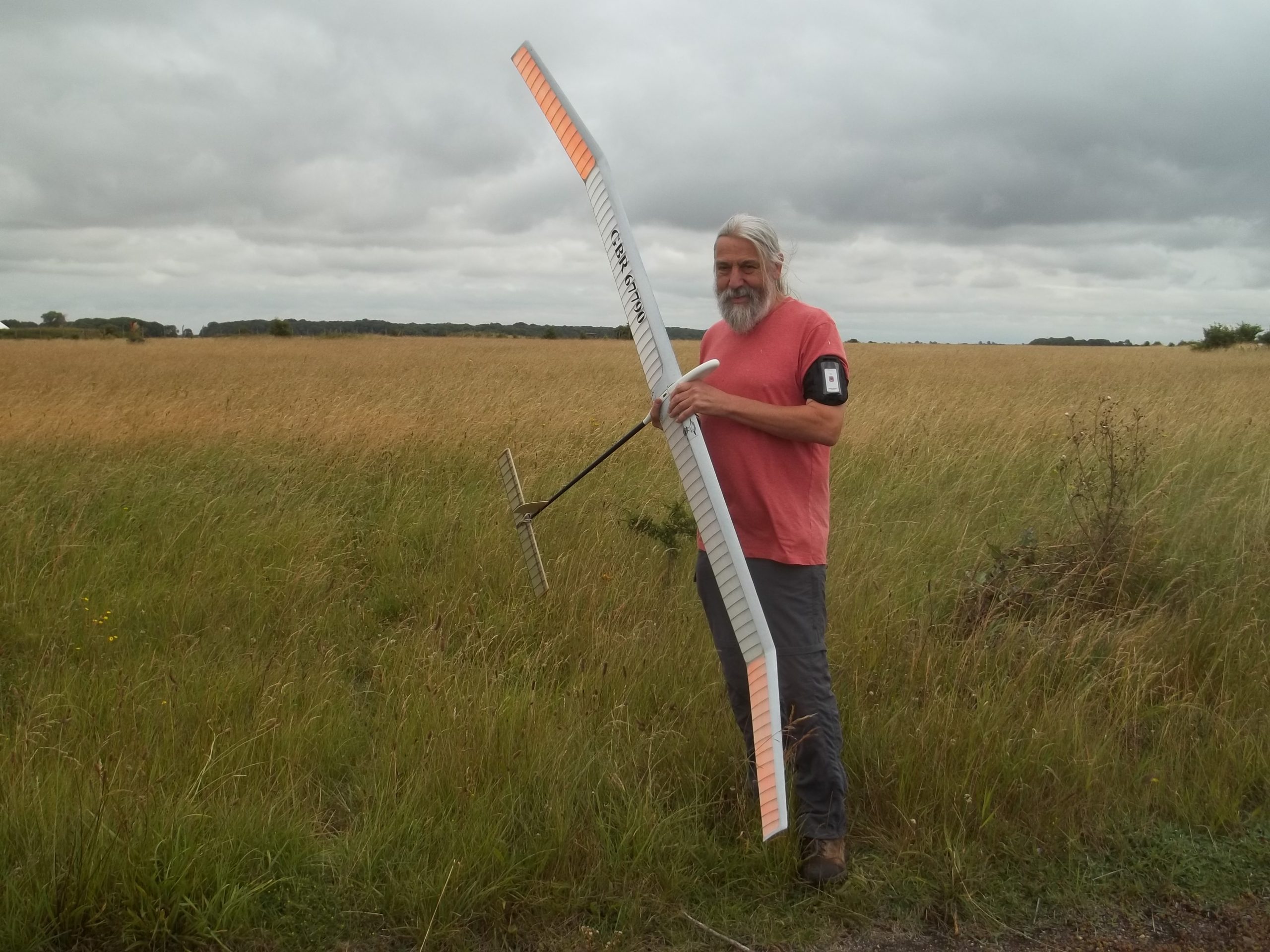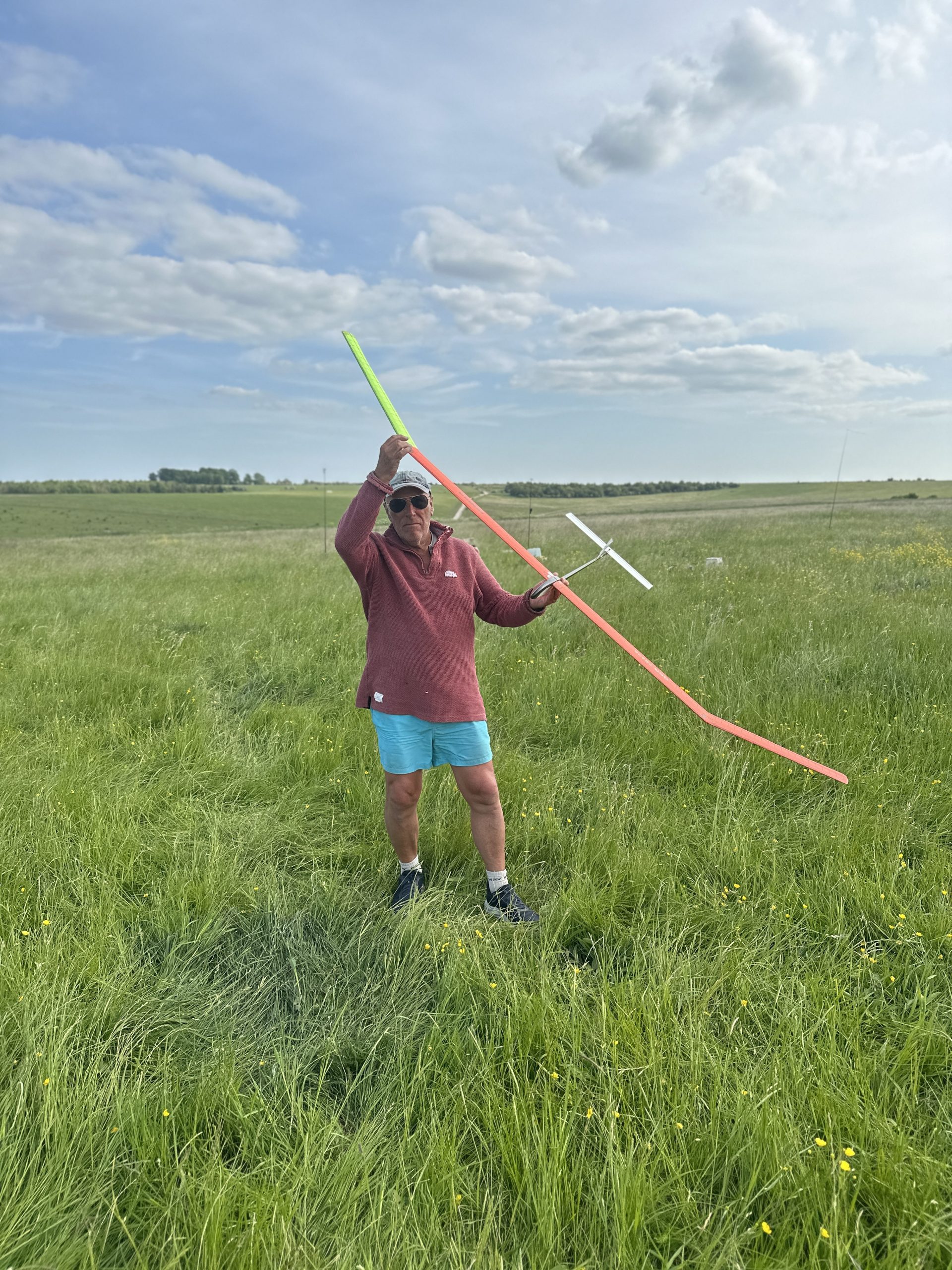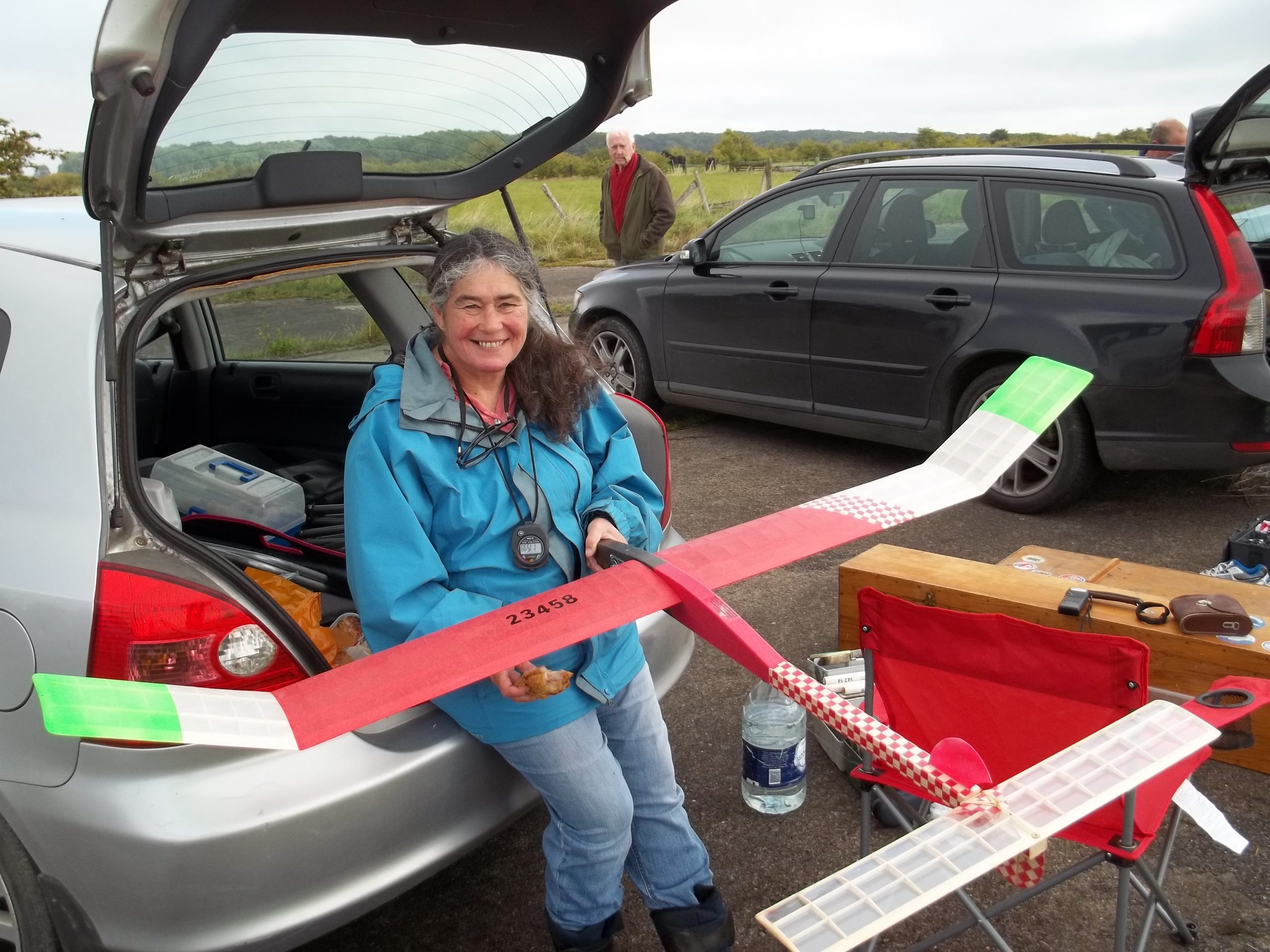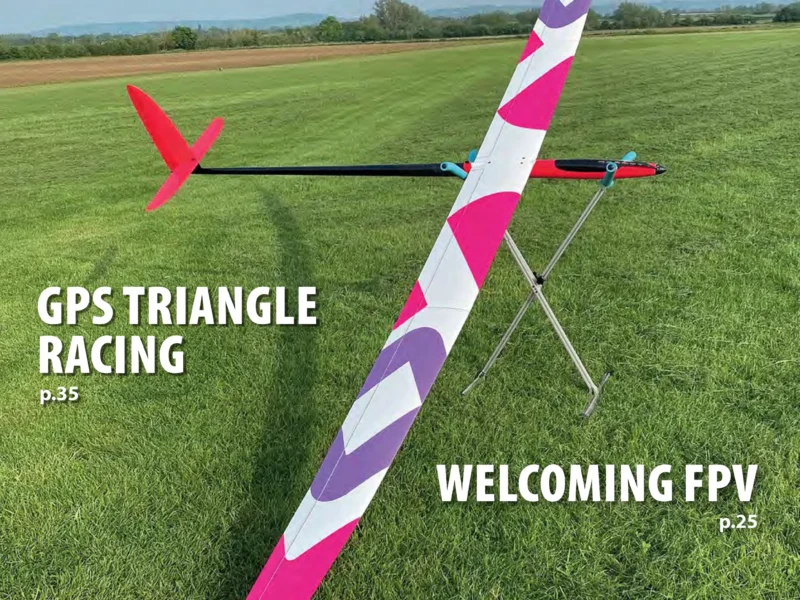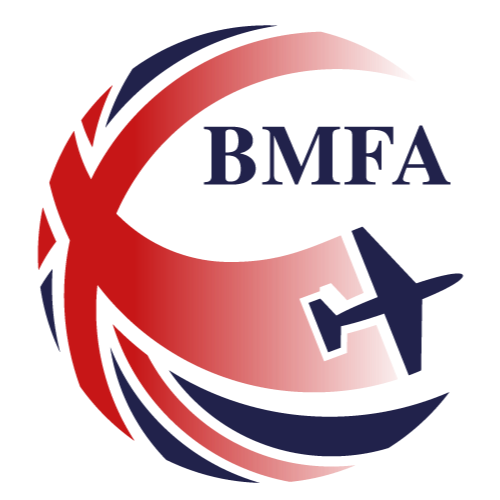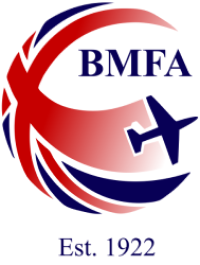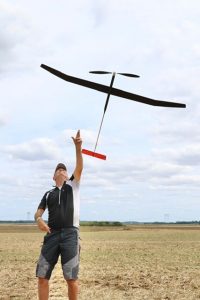12th - 19th August 2023 - Moncontour-du-Poitou, France
Reports from the F1 World Championships submitted by Mike Fantham, FSMAE
The run up the the Championships
The GBR Free Flight Team and helpers/supporters are in France for the World Championships. There are three 'Open International' World Cup Events before the main event and these are useful for Team Members to get used to the arrangements and Supporters to have some contest flying themselves.
For those not familiar with modern Free Flight, the three World Champs classes are towline glider (formerly A2 now F1A), rubber power (Wakefield/F1B) and engine powered (F1C).
Today, I'll introduce you to the gliders - more on the others later - the technology is similar in each class.
The F1A glider rules have not changed for over 60 years but the models certainly have. A really good balsa/spruce/tissue model from the late 50s might have remained aloft for 2:30 - 2:45 when floated off the 50m line in still air. Today's F1A has a lot of composites in the construction and the best are using very light spread tow carbon/epoxy skins overhead a machined foam core. Others are D-box leading edge structures with open structure behind. There is a very stiff, strong carbon spar to cope with the massive high -speed launch loads, estimated to be in the order of 50g! The line tension and launch pattern give the model enough energy to climb vertically for about 3 second after release. Some flyers deliberately fall over to get some body weight into the line tension. All functions are pre-set before release - no feedback allowed - all timed and controlled by electronics and small servos. 'Still air' times are now nearer 7:00 - 7:30! We are flying 7 flights each timed for a maximum time - if you go over, you get a max score. Maxes are 4 4 3 3 3 3 3 minutes.
Yesterday was F1B and F1C today is F1A.
In F1B, top Brit was John Carter in 12th place - he made 3:30 in the fly-off going for a 10 minute max. Dominick Andrist of Switzerland made 6:44 to win. Other GBR places were, Mike Woolner 19th (2:10 in fly-off), Phil Ball 1226 - dropped 2:34.f
Pictures from F1B - rubber powered models.
John Carter attaches the tailplane to his F1B - the tail weighs less than 5 grams!
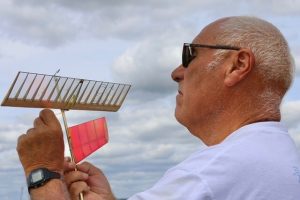
John Carter and Dawn keep cool between rounds silver mylar keeps the heat off the fuselage and the spare rubber motors.
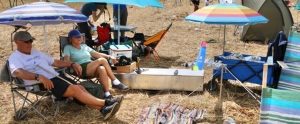
Eleven-year-old Elouan Rigault of France flew F1B - dropped one minute over seven flights (scored 1320 out of 1380) placed 33rd of 52 entries.
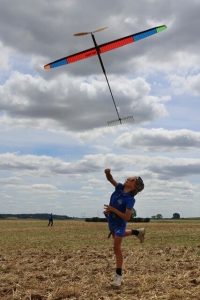
Elouan's Dad, Mikael Rigault, is the current F1B World Champion. Here he is passing a torque meter to Elouan so that the motor torque can be monitored while Elouan waits for signs of a thermal. Further 'hand turns' are put on the motor to maintain torque which otherwise fades with time.
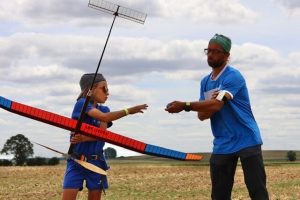
I said I'd introduce the other classes as we go - today F1B (Wakefield -rubber powered). The Wakefield trophy was presented by the Castrol Oil Man, Lord Wakefield of Hythe in 1928. The SMAE (now the BMFA) controlled rules were handed over, in the early fifties, to the International controlling body the FAI (Féderation Aeronautic International). The model minimum weight is unchanged since that date at 230 grams. During the fifties, the minimum cross-section rules and the need to “rise-off-ground' disappeared. In 1954 you were allowed 80 grams of rubber. This reduced over the years as the models and the rubber improved - we are down to 30 grams of rubber now but the performance is possibly better than 70 years ago
The rubber is 'stretch wound' outside the model on a 'half tube”. This prevents model damage should the rubber “motor” snap - they are wound to bursting point and are no good for top performance after one wind. Propellers have variable pitch which is matched to the reducing torque as the turns run off to prop fold after 45-55 seconds. Many flyers are launching with the blades locked out and 'feathered’ to get the maximum advantage from the javelin launch before the motor starts. Electronic timers control the functions including prop start, pitch, roll and rudder changes during the climb. Construction method are similar to gliders, including a lot of composites.
Back to the 9th August. This was the 'Poitou' International event for F1B rubber and F1C power. Here are some pictures.
Gongor Mijiddorj of Mongolia prepares his F1B model. Many thin strands beats fewer thick strands for energy storage efficiency.
Gongor loads the motor into the half tube ready for winding.
The model is set up and the operating lines to the tail surfaces are hooked to the release arms on the timer.
The motor is carefully stretched at the start of the winding process to achieve maximum energy input - turns applied with a geared purpose-made winder. A torque meter on the winder shows the condition of the mother as the flyer comes in at the final turns.
The motor is put back into the half tube for loading the model. Once the motor is in, the propeller is attached and the tube is slid out of the nose.
The prop blades are feathered and we are ready for the javelin launch.
Let's have a look at F1C, the power class.
All the free flight championship duration classes spend most of their time gliding - and you will see some models in all 3 classes using pre-programmed variable camber wings to adjust between best climb and best glide.
The way the F1A and F1B rules are written, there is a limited range or surface areas allowed, so variable area offers very little advantage.
F1A: 32 to 34 sq. dm., 410 grams minimum weight. 50 meter towline.
F1 B: 17 to 19 sq. dm., 200 gram min. airframe, 30 gram max. rubber.
F1C, here, the rules are framed differently.
Maximum swept volume of the internal combustion engine is 2.5cc.
The minimum weight is 300 grams per cc. The minimum surface loading is 20 grams per sq. dm. 4 second motor run.
So a 2.5 cc model must weigh at least 750 grams and has a maximum surface area of 750/20, 37.5 sq. dm. There's no minimum surface area specified. The motor has enough thrust for the 4 second climb to be vertical so the wing is doing almost nothing until the glide. To get the wing drag to a minimum, many flyers now fold the wing in 'half' or in 'thirds' for the climb. As in all free flight classes, only pre-programmed actions are allowed - no feedback loops or auto-pilot type systems. Timers are usually electronic now - they were clockwork in the past.
Here's a sequence I shot of a wing unfolding. The model does an upward cruise after the engine stops and then a quarter bunt into the un-fold …
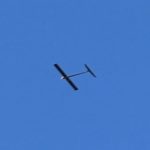
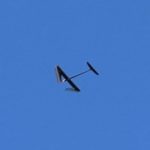
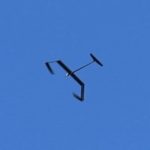
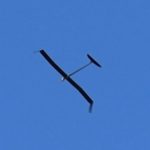
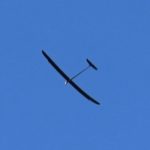
Magic! A small low-drag symmetrical section wing is replaced by a high aspect ratio wing with a glide-optimised airfoil.
The Glider contest took place on Monday 14th August. I am doing a blow-by-blow report on the BARCS Forum through the week.
https://www.barcs.co.uk/forums/topic/12320-moncontour-ff-world-champs/
The full results are on line at
http://moncontour2023.vol-libre-moncontourois.fr/seniors.html
In F1A glider, Lauri Malila of Switzerland took the title with a 6:59
Robert Helgren of Sweden, the 2003 Champion, made 6:30 for second
Alejandro Arigos of Argentina was third with 6:21
114 flyers from 41 countries competed.
GBR summary: John Carter 42nd Chris Edge dropped a mere 6 seconds over the seven flights but that pushed him down to 49th just below the flyoff group, Stuart Darmon (111) and Kris Best (106 had a tough day.
Chris Edge Launches for John Carter - colourful scheme (Martin Dilly picture)
Stuart Darmon launches for Kris Best (Martin Dilly picture)
John Carter made the flyoff with 47 others but had no luck going for six minute - he got 3:30 - but 14 of the 48 made it.
John's well-travelled model box makes a useful seat as he winds down after a hard day.
They decided to fly again and, just before sunset in a gentle breeze, the top fourteen ran out their lines.
The task was an eight minute flight in a seven minute window. About half the flyers towed straight up on the signal, spreading out and testing the air as they circled on the towlines. Soon there were 14 models on tow all over the field. The crowd of spectators were reacting to each towering launch with shouts and applause as the models were climbing vertically for 3 seconds after the high energy release. As the models drifted away in what little lift could be found, a constellation of flashing ultra-bright LEDs marked their positions as they sank slowly back to the ground. Then the electronic scoreboard started to reveal the results….
A good contest with a worthy winner. GBR team was 27th of 39.
F1B (Wakefield) was flown on Wednesday 16th August.
Peter Brown and Mark Benns made respectable flights in the F1B Wakefield flyoff but there were 50 flying and Bozo Grubic of Serbia managed the 8 minute max.
Jes Nyhegn from Denmark was 51 seconds behind in 2nd, having made sixth in F1A on Monday.
GBR placing were, Peter Brown 28th with a 5:52 flyoff, Mark Benns 33rd with a 5:33 flyoff and Mike Woolner 61st with a 13 second drop over 7 flights.
Mike Woolner launches his seventh flight, the 20th max of 21 flights from Team GBR - a good performance but there were three clean teams. Sadly Mike dropped round 5 with a 2:47
Peter Brown prepares a model
Mark Benns winds the 30 gram rubber motor.
GBR Team F1B at work. L to R: Mark Benns, Peter Brown and Mark Woolner watching a streamer upwind as Mike waits to launch. Assistant Team Manger, John Williams watches from his seat. Three weather displays and streamers in use.
Peter Brown launches in the flyoff - Mark Benns waits at left.
The GBR team placed 7th of 38 teams.
F1C power duration was flown on Friday 18th August.
Flyers, Neil Allen, Simon Dixon, Ken Faux and the rest of the GBR team were on the field at dawn preparing.
Our luck held for the first round and all three made it on the first flight where 4 minutes was the target time. In round two, Simon fell short with a 3:41. The target was dropped to 3 minutes for rounds 3 to 7. Ken dropped time in two rounds and, as round 7 started only Neil had a full score. The breeze had been increasing through the day - but we are used to that and had high hopes. Neil's flight started well but it was down for 2:41 ending our chances of a fly-off place.
31 competitors made full scores and went for 6 minutes soon after 1930. There were some less than perfect flights but many got very high and there were a few excellent transitions to slow wandering glides. You can't watch all 31 flights but one model flew way out to the left, looking downwind, descending very slowly in a buoyant patch. The super-bright red LED flasher made it easy to recognise and I saw it DT at about half climb height. There were obviously going to be several other maxes. Without the certainty that a second flyoff would follow, the heat, hunger and fayigue made us decide to head for a shower and dinner.
We followed the second flyoff action via the live internet coverage over a late pizza and a beer.
12 flyers had made the 6 minute max to qualify.
News eventually came in that Darijo Jermol of Croatia had done 7:50 to beat Ezra Shemesh of Israel with 7:24 and Viacheslav Alexandrov of Ukraine with 7:05. The great Californian friend of the GBR team, Walt Ghio, was 4th with 7:03 and Artem Babenko, the Ukrainian 'builder' of many of the models flown, was 5th with 6:31.
GBR placing were, Neil Allen and Simon Dixon tied(!) at 41st and Ken Faux at 51st. The team was 13th of 25
Neil launches his folder in round one. At the end of the 4 second run, the wings will spread for the glide.
Ken javelin launches his flapped model. The wing camber changes for the glide.
Simon sends his folder safely on its way - span will double for the floating glide.
That's it from me for this Champs - thanks for watching.
